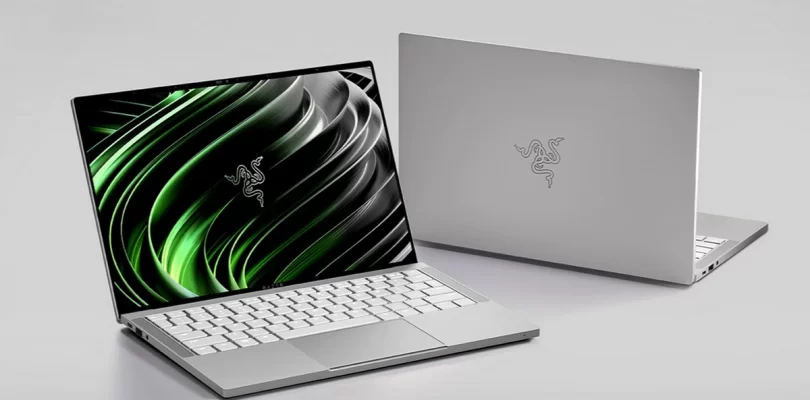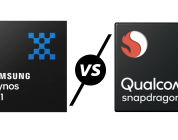Finish and elegance with a Razer touch
Being before a team with the Razer brand behind, an aspect that a priori we have assured is the taste for detail and good work at the construction level. And we are not wrong with the Razer Book 13. keep up with with this review.
Its one-piece aluminum construction with excellent and precise machining is appreciated to the touch and the eye. It is a laptop that transmits us at all times care for the finish (there is a rubber detail that protects the screen’s hinge), which should remain impeccable over time due to the feeling of robustness that it presents.
The design is quite understated, with a predominance of straight lines well complemented by the smooth curves of the edge bezels. The straight format, construction material, and compact dimensions make the 1.4 kg in weight look like something else.
In any case, it is an easy device to carry from one place to another and, as I said, very contained in dimensions thanks to the reduced screen frames, which we will see later.
We miss a fingerprint reader in the design because we only have the webcam (720p) compatible with Windows Hello as a biometric identification element. At the quality level, in addition to the correct resolution, the quality suffers a lot in low light.
The connectivity of the Razer Book 13 is balanced for a team of this size and profile. It comes with two Thunderbolt 4 compliant USB-C ports, one on each side, complemented by a USB-A 3.1 Gen1 port on the left and an HDMI 2.0 and MicroSD slot on the right side.
In the wireless connectivity section, this Razer Book 13 is a Wifi 6 and Bluetooth 5.1 device.
When talking about a brand like Razer, indifference is not an option. That is precisely the case with the screen of the Razer Book 13, which brings to the market a 16:10 format for its 13.4-inch panel. It is also a touch-type panel and offers a refresh rate of 60 Hz—nothing extraordinary at that point.
Although the resolution of the panel of the model we have analyzed was the basic one, 1080p, and not the highest with UHD resolution, the high brightness and its factory calibration (for 100% sRGB color space) result in a screen that the view is very spectacular. It even gives us a sharpness that, for a moment, made us doubt if it was the UHD version.
The high brightness and excellent anti-glare coverage of the panel result in a spectacular display.
With Gorilla Glass 6 protection, the screen exceeds 450 nits of brightness, and it also does so in a glossy panel, but whose anti-reflective treatment is the best we have seen in this type of device. Both indoors and outdoors, the reflections are practically non-existent, and the comfort of use without giving up its full potential is assured.
As indicated, the screen is of the touch type, a very precise result, and quite good at not catching fingerprints or dirt despite using the fingers to move through the operating system. Considering that it is a Windows laptop and does not have a convertible format, we find the panel with touch technology quite expendable.
At the sound level, the Razer Book 13 stands out for a fairly powerful and clear sound, balanced enough for the main destination of this Razer Book 13, although without being especially outstanding.
The speakers are conveniently positioned to the sides of the keyboard, which also gives it some design differentiation and helps make it THX certified for spatial sound.
In addition to the design, this Razer Book 13 is different from the rest of its equipment because of its technical sheet quite far from the especially expressive power that its gaming models usually show off. If anyone was expecting a little wink in the form of some dedicated graphics, this is not your team.
The Razer Book 13 comes with a perfect spec sheet for an ultrabook model to save maximum internal storage capacity.
The manufacturer has opted for Intel, so we find a Core i7-1165G7 processor (Intel EVO) well supported by 16 GB of RAM (LPDDR4x at 4267 Mhz) soldered to the board) and a large 512 GB SSD unit. Performance both in reading and writing.
With this base, the Razer laptop fully complies with ultrabook and office automation tasks; creation, content consumption, web browsing, and the like work seamlessly. The 16:10 panel and the excellent screen quality are a well-thought-out complement to spend hours and hours, both for leisure and personal or professional, to this Razer Book 13.
The figures obtained do not clash with what was analyzed this year with simulated configurations in the performance tests. Thus, with PCMark 8, we get 3146 points in the Work test and more than 5000 points in the Home test. As for Cinebench R20, the Raze Book 13 reached 1807 points.
As we have advanced, this Razer Book 13 chooses to keep the Intel Iris Xe as the only graphics solution, with much better results (finally) than the Iris of previous generations. In the tests with 3DMark, we reached 1717 and 4881 points in the Time Spy and FireStrike tests, respectively, while in Night Raid, this laptop exceeded 15600 points.
Despite being a Razer laptop, the exclusive use of the graphics integrated into the equipment keeps it from considering it proper equipment to play beyond the fact that you want to play well-known e-sports titles, where the integrated Intel has given an important leap in this generation. But do not expect anything beyond 30 fps in current games and always with the graphic settings to the minimum.
The cooling of this Razer ultrabook has been concentrated in a pair of fans that we can perfectly intuit by the two air intakes that have been “released” in the lower part of the case. There are also exits in the hinge, leaving the sides completely free.
This configuration allows the part of the use of the notebook associated with the palm rests, and the keyboard suffers little heating. It can be noticeable in the central part of the keyboard in very demanding tasks, but it is not uncomfortable or worrying.
Yes, it is if we intend to wear the Razer Book 13 on our knees. It will be impossible without protection because the heat generated is concentrated in that lower part, reaching annoying temperatures in that situation of use. In any case, it only happens when we play or demand the maximum from both the processor and the integrated graphics unit.
And it is in the situations when we can appreciate the noise of the fans in operation. It is appreciable, but nothing exaggerated. This Razer Book 13 has struck me as a fairly quiet ultrabook in most usage scenarios.




